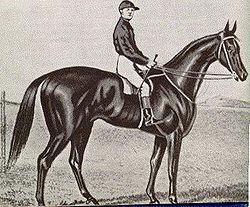

Way back when Archer won the first two Melbourne Cups, that was 1861 & 1862, racing in Australia was very different. There wasn’t any clear differentiation between stayers and sprinters. Horses raced over varying distances, often on the same day, and they also mixed flat racing and jumping. Point-to point racing, that is to say cross-country, and hunt steeplechasing were big deal, and often attracted a level of interest rivaling the major flat race meetings.
Last weekend saw a step back in time with a racing programme at Ballarat entirely made up of jumps races. The first all-jumps meeting since the 1830’s – and it was a great success!
Six races with a total of 47 starters, two major races – one for hurdlers and one for steeplechasers – and some really terrific racing on a track ideally suited for jumping. But I can hear the Twitter-fingers cranking up already. It was a Heavy 10, and with CHOOSER you don’t like Heavy 10’s. That’s true, but jumps races are different.
Let’s talk about how, and then let’s look at Sunday’s spectacular success.
The basic difference is bleedingly obvious! Jumps, mate! Lots of them, and each one harder to get over as your horse gets a little wearier. Then there are the distances – the shortest hurdles races are 2,800 metres, and the steeples are always longer than that. So the task for jockeys in jumps races carries a couple of dimensions that riding in flat racing just doesn’t face. For a start, the rider has to manage the horse’s stride and breathing to make sure that his mount is in the right place at the right time to take the next jump. Jump too early and you have to hope that the horse is part-gazelle, jump to late and you have to hope that his dad was a grasshopper! The second thing to remember is that there is a long way to go in a jumps race, right up to the 5,500 metres of the magnificent Grand Annual Steeplechase at Warrnambool, which is run on a figure 8 course in mostly open ground with 33 obstacles, more than any other steeplechase in the world. It’s the longest horse race in Australia run on a public course. Even discounting this event, most hurdle races are over 3,200 metres, same as the Melbourne Cup, and most steeples are over longer than that. Managing your horse, and training a horse to have real stamina are vital.
It’s also critical to be on a safe jumper. Horses are like people, some of them are risk-takers. So a clever jumps rider doesn’t take a ride on a horse he or she hasn’t schooled. Doing so is like making a booking in Casualty. A clever jumps rider is a cautious jumps rider. Knowing how the horse jumps means that the rider can position the horse on the approach to each jump in a way that gives the best possible chance for a safe leap – most of the time!
But by far the most important thing for a jumps jockey is to manage the horse’s stamina, by managing its’ breathing and rhythms during the race. Take it from me, being on a horse that you know is totally stuffed coming up to the last jump in a steeplechase is not a comfortable feeling! What the jockey really needs to do is to conserve as much of the horses energy as possible until the last 400 metres. That’s not so hard, actually, because everyone faces the same problem. So what you often see in jumps races is that the horses are allowed to set their own pace until the business end of the race comes around. Some like to bowl along in front, others like to sit back and work into the race gradually.
Those lucky enough to be at Ballarat on Sunday saw examples of all of that. Every race was interesting, every race had its’ highlights, every race had a story. Even the two falls that happened were harmless tumbles, almost stumbles or sprawls really, and that was due to the changes in jumps design from that of the old days.
The highlight of the day had to be the Grand Annual Steeplechase. Over 4,500 metres and 24 fences, there was a field of 9 starters including the winner of the last two Grand Nationals, Wells, the outstanding New Zealander, Sea King, the up and coming steeplechaser, Over The Yardarm and the UK import, Dormello Mo, winner of his last four steeplechase, and a horse specifically bought for steeplechasing. Wells prevailed over Over The Yardarm by a whisker after a stirring struggle over the last 400 metres, and they cleared out on the others. By winning, Wells became only the second horse, after the champion Bash Boy, to win three Grand Nationals. A bit of history in the making!
But the programme had other highlights.
The first race was the Marathon Hurdle over 4,000 metres. Race 2 was a Maiden Hurdle and was won in spectacular fashion by Shez Ektraordinary – watch this space for her in future! Dane Hussler won the third in a last to first performance for Lindsay Park, Two Hats and Chequered Flag staged a two-horse war in the J J Houlahan Hurdle, and the fifth race looks to have unearthed a real steeplechasing prospect in Trouble Bound.
All in all, the day was proof that jumps racing does have a place, can be spectacular, and is always entertaining. After the nonsense that marked the attack on jumps racing a few years ago, it was a great day! It showed how effective management and cultural changes can revitalise a sport under a bit of, sometimes ill-advised, community pressure.
Wonder if the greyhound boys were watching?
